The Most Famous Of All The Mid Century Modern Furniture Design
The A Team Of Mid-Century Modern Furniture Designers
The below photograph from a 1961 Playboy Magazine article features only a several of the masters of the mid-century modern design, a movement whose practitioners had a large and significant impact on design and décor from the mid 20th century to the present.
This seemingly plain style has a remarkable allure; it’s clean, simple, and functional, and for many it’s a bit nostalgic. Mid-Century Modern, or MCM, is essentially a design style that encompasses interior and furniture design, modernist architecture and industrial design.
MCM is most often associated with the 1950’s, though it spanned several decades. It was largely influenced by Frank Lloyd Wright’s principles of nature, simplicity, and organic form combined with industrial advances in materials and construction and elements from both the Bauhaus aesthetic and Industrial movements. Function and form had equal weight in design and there was an emphasis on fulfilling the new needs of the average American and European households.
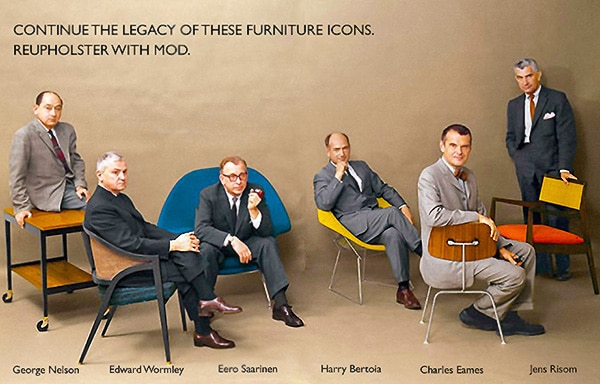
The Iconic and Famous Mid Century Modern Furniture Designers – George Nelson, Edward Wormley, Eero Saarinen, Harry Bertoia, Charles Eames, Jens Risom as published in the July 1961 Edition Of Playboy Magazine.
When talking about mid-century modern its important to mention that there was an American style and a Scandinavian style. The Scandinavian aesthetic took the clean lines of modernism and paired them with softer, more traditional properties of wood and innovations in fabrics resulting in what was a familiar and comfortable aesthetic.
These innovative pieces introduced the use of new color combinations such as bright red and gold, blue and green, Scandinavian harvest gold and avocado green and also soft pastels of pink, light yellow, sky blue and turquoise. Black and white checkerboard floors and stark white or brightly colored walls were a popular backdrop to show off the new colors.
Mid Century Modern Furniture Designer Finn Juhl
Who was Designer Finn Juhl?
Finn Juhl was a Danish furniture designer and architect, known for his significant contributions to modern Scandinavian design. He was born on January 30, 1912, in Frederiksberg, Denmark, and passed away on May 17, 1989.
Finn Juhl studied architecture at the Royal Danish Academy of Fine Arts in Copenhagen, where he developed an interest in furniture design. He is considered one of the leading figures of the Danish Modern movement, which emerged in the mid-20th century and emphasized functionality, organic forms, and craftsmanship.
In the 1940s and 1950s, Finn Juhl gained international recognition for his innovative furniture designs. His pieces were characterized by their sculptural and organic shapes, as well as a combination of solid wood with upholstered elements. He often drew inspiration from art, culture, and nature, incorporating fluid lines and dynamic compositions into his work.
One of Finn Juhl’s most iconic designs is the “Chieftain Chair,” created in 1949. This chair showcases his distinct style, with its floating seat, curvaceous arms, and expressive use of wood. The Chieftain Chair exemplifies the marriage of aesthetics and comfort, which became a hallmark of Juhl’s designs.
Finn Juhl’s work had a significant influence on modern Scandinavian design, helping to establish Denmark as a hub for contemporary furniture design during the mid-20th century. His designs continue to be revered today, and many of his iconic pieces are still in production by various furniture manufacturers.
Throughout his career, Juhl received numerous awards and honors for his contributions to design. His legacy lives on as his furniture pieces remain sought-after collectibles and continue to inspire contemporary designers around the world.
The artistic creations of designer Finn Juhl
Finn Juhl was one of the most influential of all the Scandinavian mid century modern furniture designers and is recognized for his sculptural forms. He was inspired by abstract paintings and African sculpture.

Mid Century Modern Furniture Designer Finn Juhl
We can see this influence extended to textile and rug makers such as Marta Maas Fjatterstorm. Juhl’s chieftain chair, a signature piece, would go well with so many of the mid-century vintage rugs, like this beautiful Scandinavian rug designed By Ann Marie Hoke Sodra Kalma Lans Hemslojd.
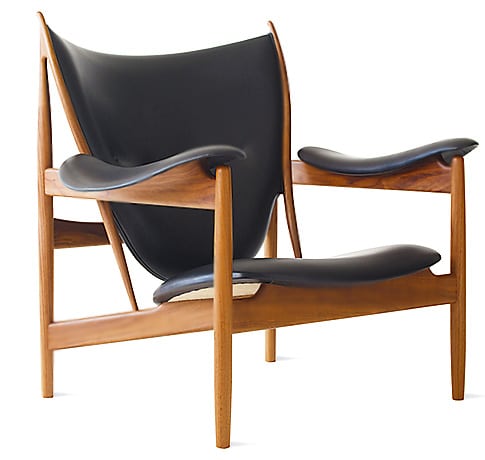
Mid Century Chieftai Chair Designed by Finn Juhl
One of Denmark’s finest cabinetmakers, Hans Wegner, combined traditional craftsmanship with modern needs in order to create functional classics. This teak credenza is a beautiful example of Wegner’s expert craftsmanship.
The American interpretation of mid-century modern design put emphasis on producing furniture that was contemporary in design, yet highly durable, made with the latest technology and affordable all at the same time. American cabinet designers followed the tenets of form follows function, but created a form less austere than the Scandinavians’.
Mid Century Designer Frank Lloyd Wright
Who was Frank Lloyd Wright?
Frank Lloyd Wright (June 8, 1867 – April 9, 1959) was an American architect, interior designer, writer, and educator, widely regarded as one of the most influential figures in modern architecture. He was born in Richland Center, Wisconsin, and became one of the foremost architects of the 20th century.
Wright’s architectural career spanned over seven decades, during which he designed over 1,000 structures, including houses, offices, churches, schools, museums, and public buildings. He was known for his innovative and organic architectural style, which sought to integrate buildings with their natural surroundings and create a harmonious relationship between the structure and the environment.
Some of his most famous architectural works include:
- Fallingwater: Located in Pennsylvania, Fallingwater is one of Wright’s most famous residential designs. Completed in 1939, it is renowned for its cantilevered design over a waterfall and its seamless integration with the surrounding landscape.
- Taliesin: Wright’s primary residence and studio in Spring Green, Wisconsin. It underwent several alterations over the years and became a reflection of his evolving architectural philosophy.
- Guggenheim Museum: Located in New York City, the Solomon R. Guggenheim Museum is a stunning example of Wright’s unique approach to museum design. Its spiraling rotunda design allows visitors to view artworks as they move along the sloping galleries.
- Robie House: Situated in Chicago, Illinois, the Robie House is considered one of Wright’s most significant Prairie style designs, characterized by its low-pitched roofs, overhanging eaves, and horizontal lines.
Wright was a proponent of what he called “organic architecture,” which emphasized the integration of the built environment with nature, the use of local materials, and the harmony between buildings and their inhabitants. He believed that architecture should be responsive to the needs of the people who would inhabit the spaces he designed.
Beyond his architectural achievements, Wright was an influential writer and educator, publishing numerous books and essays on architecture and design. He also founded the Frank Lloyd Wright School of Architecture (now the School of Architecture at Taliesin), which continues to educate aspiring architects based on his principles.
Frank Lloyd Wright’s legacy continues to be felt in the field of architecture and design, and his influence on modern architecture remains profound. His visionary ideas and groundbreaking designs have left an enduring mark on the built environment.
The artistic creations of Frank Lloyd Wright
Frank Lloyd Wright is considered the father of American modernist architecture. Following the earlier Bauhaus aesthetic, he believed form and function should be balanced, however his use of curves and his love of wood reflect his known aversion toward the more rigid and impersonal design of the German Bauhaus design.

Mid Century Modern Furniture Designer Frank Lloyed Wright
Wright felt that good design could connect people to their surroundings, especially to nature. His organic designs blended into their landscapes — natural or urban — and would greatly impact generations to come.
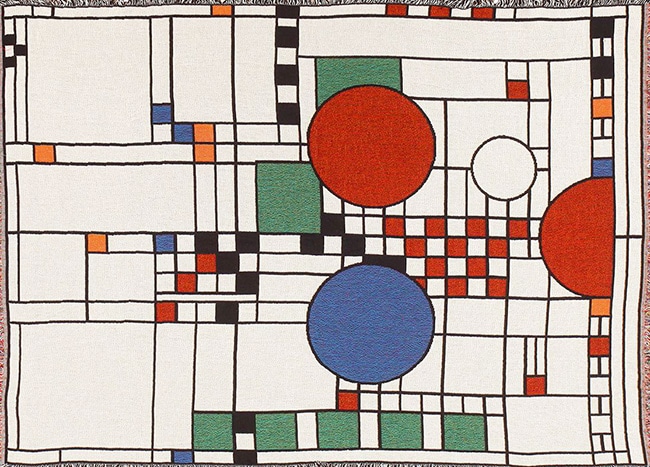
Mid Century Modern Frank Lloyd Wright Inspired Rug #49045
Mid Century Modern Furniture Designers Charles and Ray Eames
Who were Designers Charles and Ray Eames?
Charles Eames (1907-1978) and Ray Eames (1912-1988) were a husband-and-wife design duo who made significant contributions to modern furniture design and architecture. They were among the most influential and celebrated designers of the 20th century. Together, they revolutionized furniture design, industrial design, and architecture with their innovative use of materials, technology, and aesthetics.
Charles Eames was an American designer and architect, while Ray Eames was an artist and graphic designer. They met while working at the Cranbrook Academy of Art in Michigan and married in 1941. Soon after, they began collaborating on various design projects, which would become the foundation of their illustrious career.
The Eames couple is best known for their groundbreaking work in furniture design, particularly for their pioneering use of molded plywood and fiberglass in chair designs. Their most iconic design is the “Eames Lounge Chair and Ottoman,” introduced in 1956. It has become an enduring symbol of mid-century modern design and is still in production today.
In addition to furniture design, Charles and Ray Eames also excelled in other design fields, including architecture, graphic design, photography, and film. They produced a series of short films, such as “Powers of Ten,” which explored the scale of the universe, and “House: After Five Years of Living,” which showcased their own Case Study House No. 8, an influential modernist residence.
The Eameses believed in designing for the masses and embraced the concept of “good design for all.” Their work emphasized functionality, simplicity, and the use of modern industrial materials. They sought to create designs that were not only aesthetically pleasing but also practical and accessible to a wide audience.
Their dedication to design excellence earned them numerous awards and accolades during their lifetime, and their legacy continues to inspire generations of designers and architects. Today, the Eames name is synonymous with timeless and innovative design, and their iconic creations remain highly sought after by collectors and design enthusiasts worldwide.
The artistic creations of and Ray Eames
Charles and Ray Eames helped shape post war America with their pioneering contributions to architecture, industrial design, and popular culture. Together they expressed the modernist aim of combining industry and art for social good. With a common potato chip as their inspiration they devised a unique chair design: a separate back and seat both made from gently curving plywood.

Mid Century Modern Furniture Designers Charles and Ray Eames
This ergonomically comfortable piece was designated the “LCW”, or Lounge Chair Wood. The furniture manufacturer Herman Miller put it into production immediately and it was a hit and remains an iconic symbol of Mid-Century Modern.
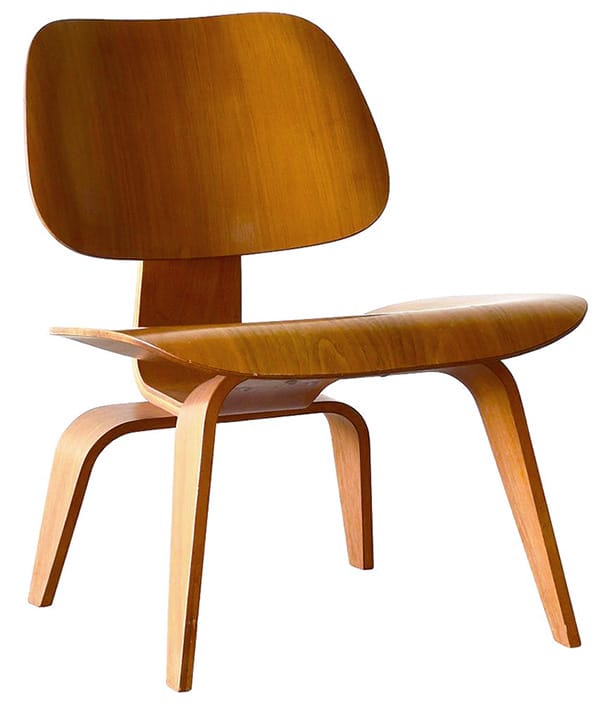
Mid Century LCW Chair Designed by Herman Miller
Mid Century Modern Furniture Designer George Nelson
Who Was Designer George Nelson
George Nelson (May 29, 1908 – March 5, 1986) was an American industrial designer, architect, and writer, known for his influential contributions to mid-century modern design. He was a prominent figure in the field of design and played a significant role in shaping American design during the 20th century.
Nelson’s career was diverse, and he made contributions in various design disciplines, including furniture design, interior design, industrial design, and exhibition design. He was also a design director for the Herman Miller furniture company from 1945 to 1972, where he played a key role in developing some of the company’s most iconic and timeless furniture designs.
Some of George Nelson’s most famous furniture designs include:
- Coconut Chair: An iconic lounge chair designed in 1955, characterized by its curved, molded fiberglass shell, and a unique shape resembling a split coconut.
- Marshmallow Sofa: Introduced in 1956, the Marshmallow Sofa is a playful design with brightly colored, circular cushions supported by a steel frame, giving it a unique and whimsical appearance.
- Ball Clock: Nelson’s Ball Clock, designed in 1947, is a famous wall clock featuring colorful wooden balls as hour markers.
George Nelson was not only an accomplished designer but also a design thinker and writer. He wrote extensively on design theory and aesthetics and co-authored the book “How to See: A Guide to Reading Our Man-Made Environment.”
In addition to his furniture designs, Nelson made significant contributions to exhibition design, including the design of the American National Exhibition in Moscow in 1959. He also curated several influential exhibitions, including “Good Design” at the Museum of Modern Art (MoMA) in New York.
George Nelson’s work helped define the aesthetics and principles of mid-century modern design, emphasizing functionality, innovation, and clean lines. His designs continue to be cherished and celebrated as iconic examples of 20th-century design, and his influence can still be seen in contemporary design trends.
The creations by mid century modern designer George Nelson
George Nelson was an industrial designer and served as director of Herman Miller. This furniture company commissioned works by leading designers of the period like Charles and Ray Eames, Eero Saarinen, and Issmu Naguchi.

Mid Century Modern Furniture Designer George Nelson
Nelson first caught the eye of the founder of Herman Miller with his creation of the Storage wall, the first modular storage system.

Mid Century Clock 4755 Designed by George Nelson

Mid Century Rosewood Credenza Designed by George Nelson For Herman Miller
Mid Century Modern Furniture Designer Eero Saarin
Who was designer Eero Saarinen?
Eero Saarinen (August 20, 1910 – September 1, 1961) was a Finnish-American architect and designer, widely recognized for his pioneering and innovative contributions to modern architecture and furniture design. He was born in Kirkkonummi, Finland, and later moved to the United States with his family in 1923.
Saarinen’s architectural style was characterized by a combination of modernist principles, organic forms, and a sculptural approach to design. He believed in creating architecture that responded to the needs of its users and the context in which it was built. His work helped define the visual language of mid-century modern architecture.
Some of Eero Saarinen’s most renowned architectural works include:
- TWA Flight Center (Terminal): Located at John F. Kennedy International Airport in New York City, the TWA Flight Center, completed in 1962, is a prime example of Saarinen’s sculptural and futuristic design style.
- Gateway Arch: One of his most iconic creations, the Gateway Arch in St. Louis, Missouri, is a stainless steel monument that stands as a symbol of the westward expansion of the United States.
- Miller House and Garden: Designed in 1957 for industrialist J. Irwin Miller and his family, this residential project in Columbus, Indiana, exemplifies Saarinen’s vision of blending architecture with nature.
- Dulles International Airport Terminal: Located in Washington, D.C., the terminal, completed posthumously in 1962, showcases Saarinen’s innovative use of curved forms and reinforced concrete.
In addition to his architectural achievements, Eero Saarinen was a prolific furniture designer. He collaborated with the furniture company Knoll International and created a range of iconic furniture pieces, including the “Tulip Chair” and “Tulip Table,” which featured smooth, organic lines and innovative pedestal bases.
Tragically, Eero Saarinen’s career was cut short when he died of a brain tumor at the age of 51. However, his work and contributions to architecture and design have left a lasting legacy. His designs continue to be revered for their timeless and forward-thinking qualities, and his impact on the field of modern architecture remains profound to this day.
The magnificent works and creations of Mid Century modern furniture designer Eero Saarinen
Eero Saarinen was a Finnish-American architect and designer. In 1932 he was appointed director of Cranbrook Academy of Art, considered to be the “cradle of American Mondenism. His most recognized furniture designs, like the aptly named Tulip and Womb chairs, were carried by Knoll, applied sculptural curves that hugged the body.

Mid Century Modern Furniture Designer Eero Saarinen
These chairs were introduced by Knoll Company and are still available today. Saarinen’s studio also designed important architectural works, most notably the Gateway Arch in St. Louis and the former TWA Flight Center at John F. Kennedy International Airport.

Mid Century Red Womb Chair Designed By Saarinen
Other designers like Vladimir Kagan, Paul McCobb, George Nakashima, and many more all deserve honorable mentions, there are so many remarkable designers of the era that there just simply isn’t room to list them all.
But it doesn’t stop there and it just wasn’t the furniture and industrial designers that have had a lasting affect on MCM. Textile and carpet makers from this era are just as important and were influenced by the new adventurous modern art, scientific discoveries of the era, and many of the same things that influenced furniture designers. Furniture designs and textile motifs were coordinated with the parallel lines and grid patterns of the architecture and the interior décor required careful laying of colors, textures, patterns, and soft furnishings to prevent a sterile look.
The motifs and designs of these rugs reflected key elements of the movement. This is where the mid-century modern rugs come into play and Scandinavian designers were influential in the textile and rug design and produced carpets that are highly sought after today.
Bauhaus Artist Kandinsky
Wassily Kandinsky, a Russian painter and an art theorist and although he was a precursor to the mid-century modern movement, later textile and carpet weavers were influenced by his abstract creations.

Wassily Kandinsky 1866 – 1944
This extraordinary modernist, Bauhaus French flat weave above taken from Wassily Kandinsky’s watercolor “Horizontales”, is a masterpiece of Abstract Expressionism and a precursor to what will be seen during the mid-century modern period.
Mid Century Modern Rug Designer – Marta Maas Fjatterstorm
Marta Maas Fjatterstorm is one of the most well known and prolific of the Swedish rug creators.

Portrait Of Märta Måås-Fjetterström
Her carpets designs include clean lines, bold colors, and have heavy tribal influences. Her use of bold color, abstract forms, and pattern offset the simple lines of the furniture that surrounded these pieces.

Mid Century Leather Lounge Chair and Ottoman Designed by Eams

Mid Century Scandinavian Rug #48830 Designed by Marta Maas (sold)
The rug above, designed and woven by Marta Maas Fjatterstorm circa 1950, and this vivid flat woven Scandinavian rug embodies the uninhibited spirit of abstract impressionism and expressionism. Kandinsky’s influence is clearly seen here in her work.
With coffered squares decorated with crenelated lozenges and stripe details embellish the low-chroma field of Marta Maas-Fjetterstrom’s Swedish rug . The rug mimics the clean and simple lines of mid-century aesthetic and both these rugs go fantastically with the Eames Lounge Chair.

Mid Century Papa Bear Chair and Ottoman Designed by Hans Wegner

Mid Century Widdicomb Occasional Table Designed by George Nakashima
This Vintage Swedish Rug below, with warm earth-tone colors, features a carefully composed pattern consisting of layered geometric motifs and would have been a perfect match with the Wegner “Papa Bear Chair” and Japanese American Designer George Nakashima’s for Widdicomb Occasional Table.

Mid Century Modern Furniture Designer George Nakashima
This delightful rug features the joyfully symbolic, beautifully colored, innocent and playful designs of the renowned Dutch artist Corneille. The set of Eero Saarien’s Tulip Chairs looks great with the bold colors in the carpet, as does Vladimir Kagan’s Serpentine sofa.

Living Room Decor with a Mid Century Serpentine Sofa by Vladimir Kagan

Mid Century Tulip Chairs Dinning Room Set Designed by Eero Saarinen
Rendered in a retro pairing of woody brown and citrine, the Scandinavian vintage Rya rug below features a clustered abstract composition embellished with geometric runes. These George Nakashima English oak burl wood nesting table, and this Ico Parisi Teak Cabinet seemed to made for this bold carpet.

Mid Century Wooden Conoid Bench by George Nakashima

Mid Century End Table and Chair Designed by George Nakashima
These innovative mid century modern furniture designer’s original designs and creations were coveted and copied around the world then and now. MCM still inspires so much of our current décor aesthetics.
A Match Made in Heaven: Mid Century Furniture and Antique Rugs
They’re two iconic design staples: mid century furniture and antique rugs. While this design combination is certainly not obvious, and may even seem to some unusual, it’s actually the perfect pairing for clean, interesting, and cultured design. It may sound strange at first thought, but you’ve actually probably seen it before, as it is becoming popular among many revered interior designers and showing up as inspirational images on sites like Pinterest. Let’s take a look at why these two are so perfect together, and how you can incorporate the pairing into your own space.
Patterns that Complement Each Other
The gentle, soft, timeless look of antique rugs is the perfect complement to the clean lines and utilitarian, modern style of mid century modern / MCM furniture. Antique Oriental rugs are often lower contrast and softly colored, due to years and years of oxidation and wear. Their patterns, while there are many different varieties, include soft and swirling floral patterns. The gentle, curved lines of these antique rugs are the perfect contrast to the angular, mod, artsy aesthetic of mid century furniture.
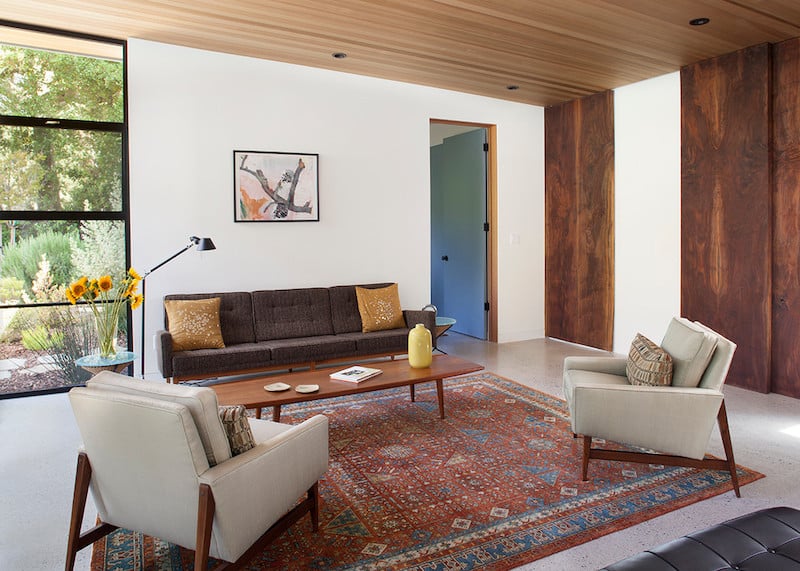
This intricate antique rug is the perfect complement to the minimal mid century furniture.
Another great complement between these two pieces are the colors. Mid century furniture so often features neutral colors and just one, sometimes two, colors in the whole piece. Conversely, handwoven antique rugs were made with a variety of natural dyes and contain so much depth and variation of color. These carpets are available in virtually any color you could ever want for your design.
The more stark the difference between the furniture and the carpet, whether in terms of colors or shapes, the more eclectic your space will be. On the other hand, if you choose furniture pieces and antique rugs with similar colors or visual movement, the space will lean towards organized and minimalist. This opens up an entire world of design possibilities, making these two the perfect combination in design.
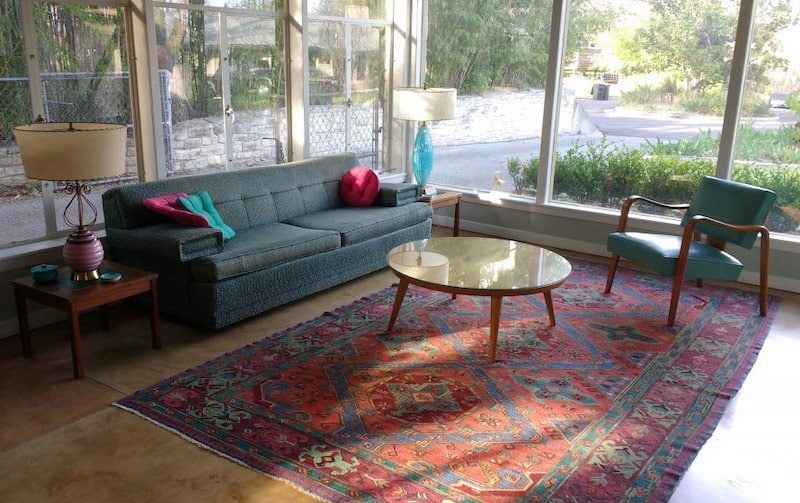
Notice how the color in the carpet is reflected in the furniture and decor pieces.
Another reason why mid century furniture and antique rugs are so perfect together in decor is because they are two of the most iconic, recognizable, classic design pieces. Although they are from different eras and from different areas of the world, they are both notorious in their own right as being hallmarks of different design movements.

This mid century Eames chair is a perfect pair with an antique rug.
Decorating with Mid Century Furniture and Antique Rugs
Mid century modern design often consists of lots of neutral colors, like tan and cream. This means that an antique Oriental carpet is the perfect piece to add an unexpected pop of color to the space. Whether you’re placing the rug under the bed in the bedroom, under the table in the dining room, under the sofa in the living room, or anywhere else, it will add a playful yet classic burst of energy to the room.
Make sure to pair your carpet with other elements in the room. Match your rug to your artwork to maintain visual flow throughout the space. Luckily, mid century modern furniture is generally unassuming and not a bold statement piece on its own, so you can really express your own personality and creativity through the art and rugs you choose.
While these are the pros to the lean lines of mid century furniture, there are cons as well. The minimalist look can make the room look empty or unfinished if not done properly. As such, your antique rug will anchor the space and fill in the visual gaps, making the perfectly put together space.

An antique rug is the perfect pop of color.
If you are feeling more playful and don’t exactly want to match your rug to your art, consider pairing the traditional aesthetic of an antique rug with the bold pop of modern art, like something Art Deco. This will incorporate a mid century modern look into your space as well as an eclectic, creative vibe.
Whichever way you choose to pair your mid century furniture and antique rugs, you will realize how perfect they are for each other. The soft antique rugs warm up the cool, sleek mid century furniture, and the furniture makes the traditional luxury of the antique rugs realistic and livable. If you need more advice on which antique rug will be perfect in your space, don’t hesitate to contact our team of experts.
Here are some beautiful modern and antique area rugs from the Nazmiyal Collection that go well with Mid Century Furniture:
Explore some of our favorite MCM rugs from our collection:
This interior design blog about famous mid century modern furniture designers was published by Nazmiyal Rug Gallery in NYC










